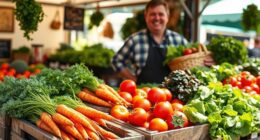Hello! Are you a self-employed herbal specialist seeking to expand your digital footprint? If so, I have just the thing for you.
In this article, I’ll guide you through the ins and outs of Google Ads, helping you plant your digital roots and reach the right audience for your herbal products.
From setting up your account to tracking your performance, I’ll share tips and best practices that will help you master the world of online advertising.
Let’s dive in and get your herbalist business blooming!

Key Takeaways
- Compelling ad copy grabs attention
- Target specific demographics, interests, and locations
- Continuously track and analyze ad performance
- Optimize keywords for relevancy and cost-effectiveness
Understanding Google Ads for Herbalists
Google Ads is a powerful tool that helps herbalists reach their target audience and promote their services effectively. In the world of digital advertising for herbalists, it’s essential to understand how to improve ad click-through rates (CTR) to maximize the impact of your campaigns.
To begin with, it’s crucial to create compelling ad copy that grabs the attention of your target audience. Use persuasive language and highlight the unique benefits of your herbal services. Incorporating relevant keywords will also help your ads appear in relevant search results.
Furthermore, optimizing your landing page is key to improving CTR. Ensure that your landing page provides valuable information and is user-friendly. Make it easy for visitors to navigate and take action, such as contacting you or purchasing your herbal products.
Another effective strategy to boost CTR is through targeted audience segmentation. Identify specific demographics, interests, or geographic locations that are most likely to engage with your herbal services. By tailoring your ads to these specific segments, you can increase the relevance and appeal of your campaigns.

Regularly monitoring and analyzing your ad performance is also essential. Pay attention to metrics such as CTR, conversion rates, and cost per click. This data will provide insights on what works and what needs improvement, allowing you to make informed decisions to optimize your ads.
Setting Up Your Google Ads Account
To set up my Google Ads account, I followed a straightforward process that allowed me to effectively promote my herbal services to my target audience.
The first step was to create a Google Ads account by visiting the Google Ads website and clicking on the ‘Start Now’ button. I then entered my email address and created a password to secure my account.
After that, I was prompted to set up my billing information, including my preferred payment method and budget for my ad campaigns.

Once my account was set up, I was ready to start optimizing my ad campaigns.
I began by conducting thorough keyword research to identify the most relevant and popular search terms related to herbal services. This helped me understand what potential customers were searching for and allowed me to tailor my ads accordingly.
I then created ad groups within my account, grouping together similar keywords and creating targeted ads for each group. This allowed me to deliver more relevant and personalized ads to my audience, increasing the chances of attracting their attention and driving them to my website.
By following these steps and continuously monitoring and adjusting my campaigns, I was able to maximize the effectiveness of my Google Ads account and reach my target audience effectively.

Now, let’s dive into the next topic: conducting keyword research for herbalists.
Conducting Keyword Research for Herbalists
When it comes to conducting keyword research as an herbalist, there are a few key strategies to keep in mind.
First, it’s important to develop effective keyword strategies that align with your specific herbal products or services. This will help you target niche audiences and maximize your search visibility, ensuring that your ads are reaching the right people at the right time.
Effective Keyword Strategies
As an independent herbalist, I rely on conducting keyword research to develop effective keyword strategies for my digital marketing efforts.

One key strategy I use is targeting long tail keywords. These are specific and highly targeted phrases that may have lower search volume but higher conversion rates. By focusing on long tail keywords such as ‘natural remedies for insomnia’ or ‘herbal supplements for anxiety,’ I can attract a more qualified audience who are actively seeking herbal solutions.
Another important aspect of my keyword strategy is incorporating negative keywords. These are words or phrases that I want to exclude from my ads to prevent irrelevant clicks and wasted ad spend. For example, I’d add ‘pharmaceutical drugs’ or ‘prescription medications’ as negative keywords to ensure my ads aren’t shown to users looking for conventional medicine.
Targeting Niche Audiences
I rely on conducting keyword research to target niche audiences as an independent herbalist, ensuring my digital marketing efforts are tailored to those seeking herbal solutions. By understanding the specific keywords and phrases that potential customers are using in their search queries, I can optimize my website and advertising campaigns to appear in relevant search results.
This helps me connect with individuals who are actively looking for herbal remedies and increases the chances of converting them into loyal customers. Additionally, I leverage social media advertising to reach a wider audience and engage with potential customers on platforms where they spend a significant amount of their time.

This targeted approach not only maximizes my marketing budget but also allows me to nurture customer loyalty by providing valuable content and personalized recommendations.
Maximizing Search Visibility
By conducting keyword research as an independent herbalist, I maximize my search visibility and ensure that my digital presence is optimized for reaching potential customers interested in herbal solutions. Here are some strategies I use to enhance my brand awareness and improve my ad quality scores:
- Identifying relevant keywords: I research and select keywords that are specific to the herbal remedies I offer, ensuring that my ads are shown to users searching for those solutions.
- Analyzing search trends: I monitor search trends related to herbal remedies to stay updated on popular topics and incorporate those keywords into my campaigns.
- Utilizing long-tail keywords: I focus on long-tail keywords that have lower competition, allowing me to target a more specific audience and increase the relevance of my ads.
- Monitoring and adjusting: I regularly review the performance of my keywords and make adjustments to ensure they’re driving the desired results.
Creating Effective Ad Campaigns
One key step in creating effective ad campaigns is conducting thorough keyword research. By identifying the right keywords, you can ensure that your ads are shown to the right audience at the right time. Start by brainstorming relevant terms that potential customers might use when searching for herbal products or services. Use tools like Google Keyword Planner or SEMrush to expand your list and discover new keyword ideas.
Once you have your keywords, the next step is creating compelling ad copy. Your ads should be concise, engaging, and highlight the unique benefits of your herbal products or services. Use persuasive language to entice users to click on your ad and learn more about what you have to offer. Don’t forget to include relevant keywords in your ad copy to improve its relevance and visibility.

Measuring ad campaign success is another crucial aspect of creating effective ads. By tracking key metrics such as click-through rates (CTR), conversion rates, and return on investment (ROI), you can determine the effectiveness of your ads and make data-driven decisions to optimize your campaigns. Google Ads provides robust tracking and reporting tools that can help you analyze the performance of your ads and make necessary adjustments to improve their effectiveness.
Optimizing Your Google Ads for Herbal Products
To effectively optimize my Google Ads for herbal products, I need to focus on targeting the right audience and maximizing the visibility of my ads. Here are some key strategies to consider:
- Measuring ROI: Evaluating the effectiveness of herbal product ads is crucial in ensuring the success of your campaign. By tracking metrics such as click-through rates, conversion rates, and cost per acquisition, you can determine which ads are generating the best return on investment (ROI). This data can then be used to refine your ads and allocate your budget more effectively.
- Adapting to market trends: Adjusting your ad strategy for changing consumer preferences is essential in staying ahead of the competition. Keep a close eye on market trends and consumer behavior to identify new opportunities or shifts in demand. By aligning your ads with these trends, you can better connect with your target audience and drive more conversions.
- Utilizing keyword targeting: Researching and selecting the right keywords is crucial for reaching the right audience. Use tools like Google Keyword Planner to identify relevant keywords with high search volume and low competition. Incorporate these keywords into your ad copy and landing pages to improve your ad’s visibility and relevance.
- Optimizing landing pages: Ensure that your landing pages are optimized for conversions. Make sure they’re visually appealing, easy to navigate, and provide clear information about your herbal products. A well-designed and user-friendly landing page can significantly increase your chances of converting clicks into sales.
By implementing these strategies, you can optimize your Google Ads for herbal products and increase your chances of success.
Now, let’s explore how tracking and analyzing your Google Ads performance can further enhance your advertising efforts.

Tracking and Analyzing Your Google Ads Performance
As an independent herbalist, I continuously track and analyze the performance of my Google Ads, ensuring the effectiveness of my advertising campaign. Analyzing ad performance is crucial for optimizing ad campaigns and maximizing return on investment. By monitoring key metrics such as click-through rates, conversion rates, and cost per click, I can identify which ads are performing well and which ones need improvement.
One important metric to track is the click-through rate (CTR). This tells me how many people are clicking on my ads compared to the number of times they’re shown. A high CTR indicates that my ads are relevant to my target audience and attracting their attention.
Conversion rate is another vital metric to analyze. It measures the percentage of people who take the desired action, such as making a purchase or filling out a contact form, after clicking on my ads. By optimizing my landing page and ad copy, I can increase my conversion rate and generate more leads or sales.
Lastly, I closely monitor the cost per click (CPC) to ensure I’m getting the most value for my advertising budget. By identifying keywords with high CPC but low conversion rates, I can make informed decisions on where to allocate my budget and optimize my ad campaigns for maximum ROI.

Budgeting and Managing Your Google Ads Campaigns
I carefully budget and manage my Google Ads campaigns as an independent herbalist, ensuring maximum efficiency and effectiveness in my advertising efforts. Here are some key strategies I employ to achieve Google Ads campaign success and measure advertising ROI:
- Set clear goals: Before starting any campaign, I define specific objectives such as increasing website traffic or boosting online sales. This helps me stay focused and measure the success of my ads accurately.
- Optimize keywords: I conduct thorough keyword research to identify the most relevant and cost-effective keywords for my ads. By targeting the right keywords, I can reach my target audience more effectively and minimize unnecessary spending.
- Monitor performance regularly: I keep a close eye on the performance of my ads, analyzing metrics like click-through rates (CTR), conversion rates, and cost per acquisition (CPA). This allows me to identify any underperforming ads or keywords and make necessary adjustments to improve overall campaign performance.
- Test and iterate: I constantly test different ad variations, landing pages, and targeting options to find the winning combination that generates the best results. By continuously iterating and optimizing my campaigns, I can maximize my advertising ROI and achieve long-term success.
Tips and Best Practices for Herbalist Advertisers
By implementing these tips and best practices, herbalist advertisers can optimize their Google Ads campaigns for maximum effectiveness and drive growth for their businesses.
Herbalist advertising strategies should focus on targeting the right audience for their herbal products. Start by conducting thorough market research to identify the specific demographics and interests of your target customers. This will help you create compelling ads that resonate with your audience and increase click-through rates.
When creating your ads, make sure to highlight the unique benefits and features of your herbal products. Use captivating headlines and ad copy that entices users to click on your ads and learn more about your offerings. Incorporate keywords related to herbal remedies, natural healing, and wellness to improve the visibility of your ads in relevant search queries.

To further optimize your campaigns, consider using ad extensions to provide additional information and enhance your ads. This can include call extensions to encourage phone calls, site link extensions to direct users to specific landing pages, and location extensions to promote local herbalist services.
Regularly monitor and analyze the performance of your ads to identify areas for improvement and make data-driven decisions to optimize your campaigns.
Frequently Asked Questions
How Long Does It Take to See Results From Google Ads for Herbalists?
It typically takes a few weeks to start seeing results from Google Ads for herbalists. Measuring key metrics like click-through rate and conversion rate can help optimize ad copy and keywords for better results.
Can I Target Specific Geographic Areas With My Google Ads for Herbal Products?
Yes, you can target specific geographic areas with your Google Ads for herbal products. However, there are geotargeting limitations that you should be aware of. By optimizing your ad targeting, you can reach your desired audience effectively.

Are There Any Restrictions on the Types of Herbal Products That Can Be Advertised on Google Ads?
There may be restrictions on the types of herbal products that can be advertised on Google Ads. It’s important to understand the legality of herbal product advertising and ensure compliance with any regulations.
How Can I Improve the Click-Through Rate of My Google Ads for Herbalists?
To improve my Google Ads click-through rate for herbalists, I focus on improving ad relevancy and optimizing ad copy. By crafting compelling and informative ads, I can attract more potential customers and increase engagement.
Is It Possible to Track the Return on Investment (Roi) of My Google Ads Campaigns for Herbal Products?
Measuring the effectiveness and tracking the ROI of my Google Ads campaigns for herbal products is possible. By optimizing my campaigns and using tracking tools, I can monitor the success of my ads.
Conclusion
In conclusion, by utilizing Google Ads, independent herbalists can effectively plant their digital roots and reach a wider audience.

Through conducting thorough keyword research, creating compelling ad campaigns, and optimizing their ads for herbal products, herbalists can maximize their online presence.
By tracking and analyzing performance, managing budgets, and following best practices, herbalists can ensure their Google Ads campaigns are successful.
So, take the leap and let your herbal business flourish in the digital world with Google Ads.










